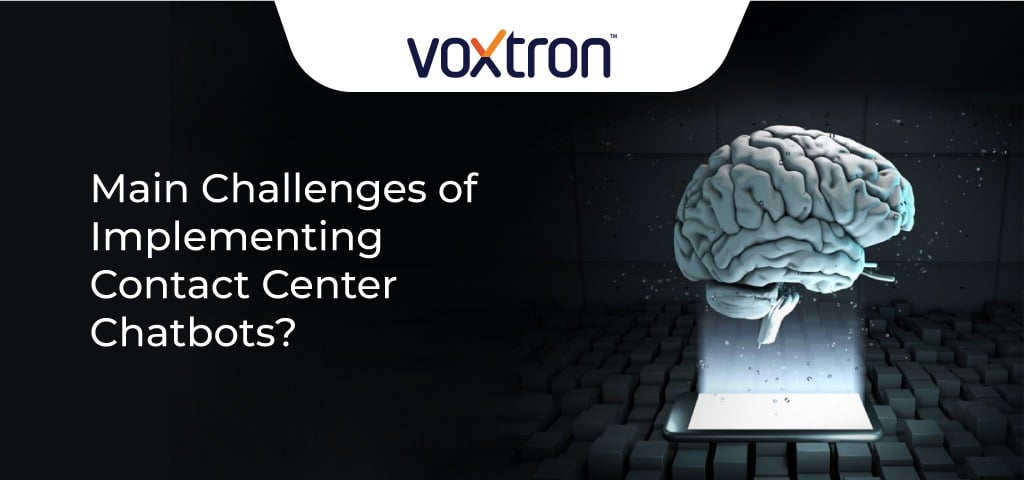
Key Benefits of Using AI in Contact Centers
February 2, 2024
Practical strategies to Successfully Navigate Odoo ERP Implementations
February 21, 2024What are the Main Challenges of Implementing Contact Center Chatbots?
According to Gartner, chatbots will be the primary customer service channel for most service-based organizations by 2027. With automation and AI racing forward, it’s evident that chatbots will play a crucial role in reshaping the contact center scene.
To stay ahead of the curve, it’s essential to recognize that chatbot implementation or upgrades in contact centers come with its own set of exciting challenges.
Let’s find out more about these inherent challenges and more importantly, how to tackle them.
Main challenges of implementing chatbots in contact centers
A chatbot developed and deployed using best practices delivers significant value to a business.
Hence, CSS leaders should invest time and resources in designing or implementing the right chatbot model to achieve the desired CS and business outcomes.
When you overlook it and forego best practices when developing the chatbot, it can result in
- Poor performance and failure to deliver self-service benefits as expected
- Resistance from customers in accepting the chatbot service
- Issues with deployment that lead to additional costs and delays
Recognizing the primary challenges will enable you to overcome these issues. So, let us look at what are the main considerations when deploying a chatbot.
Planning for customer-centricity
The cornerstone of a successful chatbot strategy is acceptance by the customer. Hence, it is extremely important to design the chatbot workflow according to customer intent.
Research suggests that 67% of customers use chatbots for basic questions or troubleshooting. Hence, the chatbot flow should be designed with this factor in mind.
Chatbots should offer relevant and personalized content to direct the customer. Additionally, using the chatbot should be low effort even while there is emphasis on secure authentication and authorization mechanisms.
Mapping chatbot flow to enterprise ecosystem dependencies
While aiming for customer-centricity, it is important to keep the overarching business goals in mind.
The chatbot is only one aspect of the flowchart of the customer service platform. It should seamlessly integrate with the rest of the system for efficient operation.
To enable this, review the dependencies within the enterprise ecosystem. Find out which technology capabilities can be leveraged as-is and which ones need enhancements to integrate with the chatbot. Next, identify the technology capabilities that are lacking and need investment.
Creating this dependency list is critical to plan staffing and expertise requirements, as well as estimating the cost and time required for deployment. This exercise should ideally be the first phase of chatbot deployment.
Identifying suitable use cases
A well-designed chatbot can greatly replace human-assisted inquiries. However, its success will depend on choosing the right use cases in the pilot.
Keep it simple and impactful by addressing scenarios aligned with customer needs and business goals.
In this context, we can broadly divide customer and business intent into the following levels:
Low complexity cases: Saves costs and boosts revenue
An example is when new customers do not opt for paperless billing. This can result in additional costs for paper statements. A simple approach would be to proactively engage customers during onboarding, using the chatbot to educate them about the benefits of paperless billing. The chatbot can guide them through the opt-in process, emphasizing cost savings and convenience.
High-volume, low complexity assisted-service
When customers frequently contact the business for an update on their order status or loan application, it makes sense to integrate the chatbot with the order tracking system. When customers inquire about their orders, the chatbot can quickly retrieve real-time information, providing instant updates. Moreover, the chatbot can be designed to understand and respond to common queries related to order processing and delivery. This ensures a high-quality and efficient customer service experience, reducing the need for human intervention in routine order status inquiries.
High-complexity use cases where there is a handover between bot and agent.
When customers seek an upgrade or want to discuss options to select the best product offered by the business for their specific budget and needs. In addressing these high-complexity scenarios, the chatbot should play a role in initial interactions, gathering essential information about the customer’s preferences and budget constraints. Once the complexity surpasses the bot’s capabilities, it seamlessly hands over the conversation to a human agent. This handover should be smooth, with the agent having a comprehensive understanding of customer needs. This collaborative approach ensures a personalized and expert-guided experience, combining the efficiency of automation with the nuanced decision-making abilities of human agents for complex inquiries.
These use cases will determine the technology required for the chatbot. It will also directly affect the cost.
Multiple Language Support
One of the biggest challenges of deploying chatbots is replicating the human touch in multiple languages. When customers contact the contact center, it is for a swift resolution. They also seek a seamless experience that is most effectively delivered by bots programmed to mimic humans.
For businesses offering multi-language support in their contact centers, replicating the human touch can be more challenging. Generative AI models use NLP or natural language processing to mimic humans. However, it is still in the nascent stage and presents some drawbacks when adjusting to different languages, dialects, and colloquial terms.
In this case, a continuous effort to study the responses delivered and optimize the model becomes essential.
Choosing the right implementation partner for your chatbot journey
One of the most important factors for a successful chatbot deployment is choosing the right technology partner.
Chatbot technology is complex and it is even more challenging to integrate one with the existing business goals. Hence, the vendor you choose should have the expertise to understand your business goals and provide a scalable, adaptable, and well-supported solution. Equally important is their availability for ongoing support.
At Voxtron, we specialize in all facets of contact center technologies. Our in-house product, Engage 360, exemplifies our expertise in chatbot technology. With Engage 360, our team of experts ensures a smooth integration. Furthermore, we optimize it for scalability and adaptability, as well as deliver continuous support.
To learn more about the capabilities of Engage 360 and how to optimize it for your business needs, contact our team today.




